|
|
Excerpts from Curiosities
of Human Nature, 1849

Curiosities of Human Nature, “by the author of PETER PARLEY'S TALES”, published by Rand and Mann, Boston, 1849
Biographies of unusual characters have been a widely popular form of literature through the ages. Curiosities of Human Nature is exemplary of the form, providing brief narratives of fifty-eight
personalities ranging from Blaise Pascal to Chang & Eng, the original Siamese Twins. I have here excerpted portions relating to some of the more unusual people relevant to the history of sideshow, and have appended notes of my
own where appropriate. J.M.
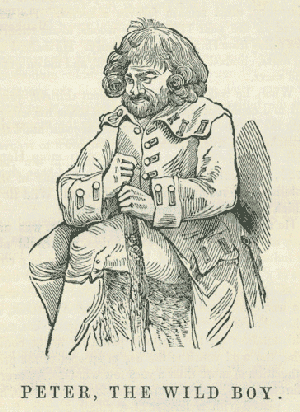
PETER, THE WILD BOY (pp 271-273):
On the continent of Europe, portions of which are interspersed with
vast forests and uncultivated tracts, various individuals of the human
species have, at different times, been discovered in a state no better
than that of brute creation. One of the most singular of these unfortunate
creatures was Peter the Wild Boy, whose origin and history, previous to
his discovery, must remain forever a secret. He was found in the year
1725, in the woods, about twenty-five miles from Hanover, in Germany.
He walked on all fours, climbed trees like a squirrel, and fed on grass
and moss.
When he was taken, he was about thirteen years old, and could not
speak. He soon made his escape into the woods, where he concealed himself
amid the branches of a tree, which was sawed down to recover him. He
was brought over to England, in the year 1726, and exhibited to the king
and many of the nobility. He received the title of Peter the Wild Boy,
which name he ever afterwards retained.
He appeared to have scarcely any ideas, was uneasy at being obliged
to wear clothes, and could not be induced to lie in a bed, but sat and
slept in a corner of a room, whence it was conjectured that he used to sleep
on a tree for security against wild beasts. He was committed to the care
of Dr. Arbuthnot, at whose house he was to have been baptized; but notwithstanding
all the doctor's pains, he never could bring the wild youth to the use
of speech, or the pronunciation of more than a very few words. As every
effort to give him an education was found to be vain, he was placed with
a farmer at a small distance from London, and a pension was allowed him
by the king, which he enjoyed till his death, which occurred in 1785, at
the age of about seventy-three years.
Peter was of low stature, and always wore his beard. He occasionally
wandered away from his place of residence, but either returned or was
brought back. He was never mischievous; he was remarkable for his strength;
became fond of finery and dress, and at last, was taught to love beer and
gin. He was a lover of music, and acquired several tunes. He also became
able to count as far as twenty, and could answer a few simple questions.
He learned to eat the food of the family where he lived, but in his excursions,
he subsisted upon raw herbage, berries and roots of young trees. He was
evidently not an idiot, but seemed to continue in a state of mental infancy,
thinking of little beyond his physical wants, and never being able to conceive
of the existence of a God.
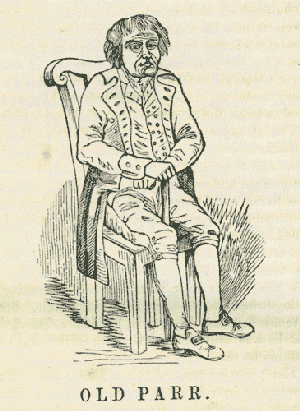
OLD PARR (pp 294 - 297):
The extreme limit of human life, and the art of attaining it, has
attracted the attention of mankind in ancient as well as modern times.
Cornaro, an Italian, who died at the age of one hundred and four years,
in 1566, wrote several treatises on the subject, the purpose of which was
to prove that sobriety of life is the great secret of longevity…
The oldest man of whom we have any account in modern times, was Henry
Jenkins, who resided in Bolton, Yorkshire. The only history we have of
him was given by Mrs. Saville, who conversed with him, and made inquiries
respecting him of several aged persons in the vicinity. He was twelve
years old at the time the battle of Flodden Field was fought, in 1513, and
he died, December 8th, 1670. He was, therefore, 169 years old when he
died.
Of the celebrated Thomas Parr, we have a more particular account,
furnished by Taylor, the Waterman, or Water-poet, as he is usually called.
This is entitled “The Olde, Olde, very Olde Man; or the Age and Long Life
of Thomas Parr, &c.” It appears that the Earl of Arundel, being in
Thropshire, heard of Parr, who was then, 1635, one hundred and fifty-two
years old. Being interested in this extraordinary case of longevity, the
earl caused Parr to be brought to London, upon a litter borne by two
horses. His daughter-in-law, named Lucy, attended him, and, “To cheer
up the olde man, and make him merry, there was an antique-faced fellow,
called Jacke, or John the Foole,” of the party. Parr was taken to court,
and presented to Charles I. He died in London soon after his arrival, and
was buried in Westminster Abbey, 1635.
Whether Parr's long life was greatly lengthened beyond that of ordinary
men by a particular mode of living, we have not the means of telling.
It is probable that there was something peculiar in his constitution.
His body was dissected after death, and all the organs were found in a perfect
state. We are also informed by an eye-witness, that
"From head to heel, his body had all over
A quick-set, thick-set, nat'ral hairy cover."
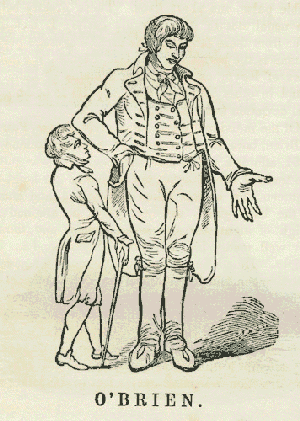
O'BRIEN (pp 298 - 299):
That men of extraordinary stature, called giants, have frequently
existed, we know, but there is no good reason to believe that the general
stature of man was ever different from what it now is. If men were either
smaller or larger than they are, they would be ill proportioned to the
condition of things around them; beside, those of extraordinary height
have usually a feeble pulse, and short lives. Those greatly below the
usual stature, generally die early. It is fair to infer from these facts,
that the present average height of man is the permanent standard. Among
the mummies of Egypt, or the ancient remains of mankind found in other
countries, there appears to be no general deviation from the common height.
Of the individual instances of great stature, Patrick O'Brien, born
in the county of Kinsale, Ireland, in 1761, affords a memorable instance.
He was put to the trade of a bricklayer, but such was his height at eighteen,
that he was taken to England, and shown as the Irish giant. At twenty-five
he attained the height of eight feet and seven inches; and though not
well made, his bulk was proportioned to his height. He continued to
exhibit himself for several years, when, having realized an independence,
he retired to the vicinity of Epping forest, where he died, in 1806.
He was peculiarly mild and gentle in his character and manners. His body
was enclosed in a leaden coffin, 9 feet 2 inches long, and to prevent
any attempt to disturb his remains, his grave, by his own direction,
was sunk twelve feet in the solid rock.
[Note: Patrick O'Brien (whose surname was actually Cotter)
was only one of several tall eighteenth century performers billed as
“O'Brien, The Irish Giant”. Charles Byrne, also born in Ireland in 1761
(quite a year for giants), preceded Cotter in the title and found early
success in Edinburgh and London while also attracting ghoulish curiosity
from a number of surgeons. Desirous of dissecting Byrne's lanky corpse,
the anatomist John Hunter allegedly went so far as to hire a man to follow Byrne around in case
he expired suddenly. With his health failing in 1783, Byrne contracted
with a group of fisherman to dispose of his body at sea. When Byrne finally
died, Hunter reportedly got the fisherman drunk, bribed them with 500 pounds sterling,
and thereby acquired the giant's corpse — which Hunter boiled in a large
kettle to facilitate the preparation of the skeleton for mounting. Byrne's
skeleton today resides in the Hunterian Museum of the Royal College of
Surgeons of England in London. For many years it was displayed beside the skeleton of Caroline Crachami, the Sicilian Fairy.
Presumably, Cotter wished to avoid Byrne's fate. (for more on Charles
Byrne, see Jan Bondeson's essay “Three Remarkable Specimens in the Hunterian
Museum” in A Cabinet of Medical Curiosities , Cornell University
Press: 1997)]
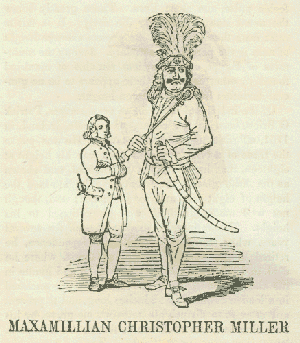
MAXAMILLIAN CHRISTOPHER MILLER (p 300):
This man was born at Leipsic, in 1694, and finally attained the height of eight feet. He traveled through Europe, being exhibited as a giant.
He went to England in 1733, where he attracted attention by his great size, his enormous head and face, and his fantastic attire. His hand
measured a foot, and his finger nine inches. He died in London, in 1734, aged 40.
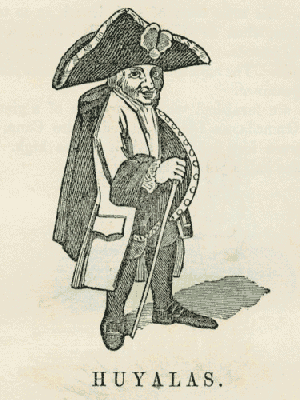
HUYALAS (p 301):
It was formerly said that the Patagonians were a race of giants,
but it seems that they are but little larger than other races of men.
South America appears to furnish its share of persons of extraordinary
height. An instance is furnished in Basileo Huyalas, who was a native
Indian of Peru, and was brought from the city of Ica to Lima, in May,
1792, to be exhibited on account of his enormous stature and extraordinary
appearance.
His height was seven feet two inches and a half: his head, and the
upper parts of his body, were monstrous. His arms were of such length
as to touch his knees, when he stood erect. His whole weight was 360
pounds. At this period he was twenty-four years old. The annexed sketch
gives a good idea of his appearance.
We are furnished with an account of a giant of New Granada, an Indian,
named Pedro Cano, who was seven feet five and a half inches high. His
shoe was half a yard in length!
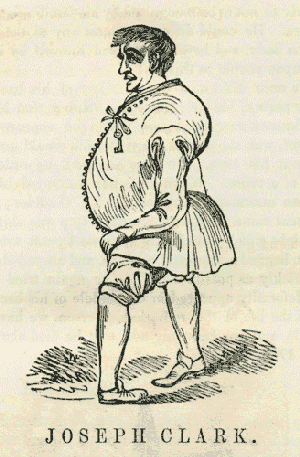
JOSEPH CLARK (pp 307-308):
In a work devoted to the curiosities of human nature, we must not
omit Joseph Clark, of London, a man whose suppleness of body rendered him
the wonder of his time. Though he was well made, and rather gross than
thin, he could easily exhibit every species of deformity. The powers of
his face were even more extraordinary than the flexibility of his body.
He would suddenly transform himself so completely as not to be recognized
by his familiar acquaintances. He could dislocate almost any of the joints
of his body, and he often amused himself by imposing upon people in this
way.
He once dislocated the vertebrae of his back and other parts of his
body, in such a manner, that Molins, the famous surgeon, before whom he
appeared as a patient, was shocked at the sight, and would not even attempt
a cure. On one occasion, he ordered a coat of a tailor. When the latter
measured him, he had an enormous hump on his left shoulder; when the
coat came to be tried on, the hump was shifted to the right side! The
tailor expressed great astonishment, begged a thousand pardons, and altered
the coat as quickly as possible. When he tried it on, the deformity appeared
in the middle of his back!
Of the life of this remarkable person, we have a few details, and
we can only add that he died about the year 1700.
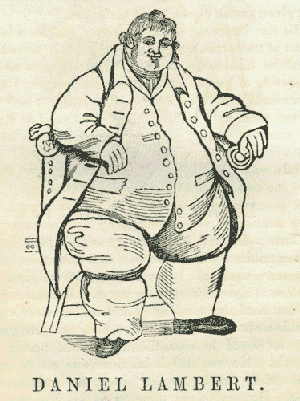
DANIEL LAMBERT (pp 310-311):
This individual was born at Leicester, England, in 1770, and was apprenticed to the business of a die sinker and engraver. He afterwards
succeeded his father as keeper of the prison; and from this period, his size began to increase in a remarkable degree. In this situation he continued
for some years, and so exemplary was his conduct, that when his office was taken away, in consequence of some new arrangements, he received an annuity
of fifty pounds for life, as a mark of esteem, and the universal satisfaction he had given in the discharge of his duties.
His size increased to such a degree, that he was an object of universal wonder, and was at last persuaded to exhibit himself in London. Here
he was visited by crowds of people, and, among the rest, by Count Boruwlaski, the Polish dwarf. The contrast between the two must have been striking
indeed; for as Lambert was the largest man ever known, so the count was one of the smallest. The one weighed 739 pounds, and the other probably
not over 60. Here were the two extremes of human stature.
In general, the health of Lambert was good, his sleep sound, his respiration free. His countenance was manly and intelligent; he possessed
great information, much ready politeness, and conversed with ease and propriety. It is remarkable that he was an excellent singer, his voice
being a melodious tenor, and his articulation clear and unembarrassed. He took several tours through the principal cities and towns of Great
Britain, retaining his health and spirits till within a day of his death, which took place in June, 1809. His measure round the body was 9 feet
4 inches, and a suit of clothes cost him a hundred dollars!
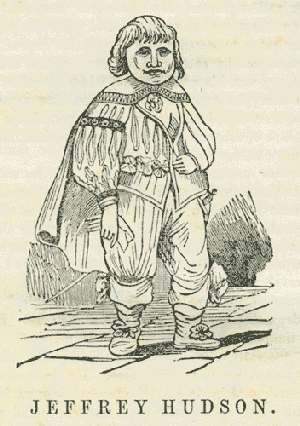
JEFFREY HUDSON (pp 312-313):
In the early ages of the world, when knowledge chiefly depends upon tradition, it is natural for mankind to people the universe with a thousand imaginary beings. Hence the stories of dragons, giants, and dwarfs,
all of which have some foundation in reality; but when these are scrutinized, the dragon becomes only some wild beast of the forest, the giant is a man of uncommon size, and the dwarf of uncommon littleness.
We have already given some account of giants; we must say a few words in respect to dwarfs. These have never been known to be distinguished for their talents, though their figures are often perfectly well formed.
They have generally one trait in common with children — a high opinion of their own little persons, and great vanity. In the middle ages, and even down to a much later period, dwarfs were a fashionable appendage to royal
courts and the families of nobles.
Among the most celebrated of this class of persons was Jeffrey Hudson, born at Oakham, England, in 1619. At seven years of age, he was taken into the service of the Duke of Buckingham, being then but eighteen inches
high. He afterwards was taken into the service of the queen of Charles I., who sent him to the continent on several confidential commissions. His size never exceeded three feet nine inches, but he possessed a good
share of spirit, and, on the breaking out of the civil wars, he became a captain of horse.
On one occasion, he went to sea, and was taken by a Turkish corsair, and sold for a slave; but he was fortunately ransomed, and enabled to return to England. When the infamous Titus Oates pretended to reveal
a plot against the king, Charles II., Hudson was one of the suspected persons, and, in consequence, lay some time in prison. He was at length released, and died in 1678.
[Note: for a more detailed account of the life of Jeffrey
Hudson, please see Nick Page's comprehensive Lord Minimus: The Extraordinary
Life of Britain's Smallest Man, St. Martin's Press: 2002]
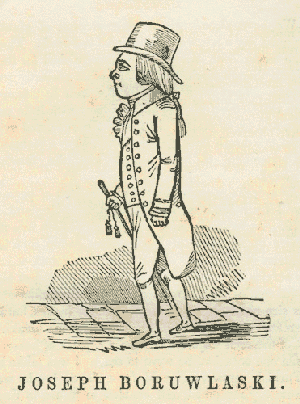
JOSEPH BORUWLASKI (pp 314-317):
This little personage was one of the most famous and agreeable of
the pigmy race to which he belonged. He was a native of Poland, and,
on account of his diminutive size, was early taken under the care of a
lady of rank. She soon married, however, and he was transferred to the
Countess Humieska, and accompanied her to her residence in Podolia. Here
he remained for six months, and then attended the countess on a tour of
pleasure through Germany and France. At Vienna, he was presented to the
empress queen, Maria Theresa, being then fifteen years old. Her majesty
was pleased to say that he was the most astonishing being she ever saw.
She took him into her lap, and asked him what he thought most curious
and interesting in Vienna. “I have observed nothing,” said the little
count, smartly, “so wonderful as to see such a little man on the lap of
so great a woman.” This delighted the queen, and, taking a fine diamond
from the finger of a child five or six years old, who was present, placed
it on his finger. This child was Marie Antoinette, afterwards queen of
France; and it may be easily imagined that Boruwlaski preserved the jewel,
which was a very splendid one, with religious care.
From Vienna, they proceeded to Munich and other German cities, the
little companion of the countess everywhere exciting the greatest interest
and curiosity. At Luneville, they met with Bébé, a famous
French dwarf. A friendship immediately commenced between the two little
men, but Bébé was four inches the tallest, and Boruwlaski,
being therefore the smaller of the two, was the greatest wonder. He was
also remarkable for his amiable and cheerful manners. These things excited
the jealousy of Bébé, and he determined to take revenge. One
day, when they were alone, slily [sic] approaching his rival, he caught
him by the waist, and endeavored to push him into the fire. Boruwlaski
sustained himself against his adversary, till the servants, alarmed by the
noise of the scuffle, came in and rescued him. Bébé was now
chastised and disgraced with the king, his master, and soon after died of
mortification and spleen.
The travelers now proceeded to Paris, where they passed more than
a year, indulging in all the gaieties of that gay city. They were entertained
by the royal family and the principal nobility. M. Bouret, renowned for
his ambition and extravagance, gave a sumptuous entertainment in honor
of Boruwlaski, at which all the table service, plates, knives and forks,
were of a size suited to the guest. The chief dishes consisted of ortolans
and other small game.
The countess and her charge returned to Warsaw, where they resided
for many years. At twenty-five the count fell in love with a French
actress, but she made sport of his passion, and his little heart was
nearly broken. When he was forty years old, the black eyes of Isalina
Barboutan, a domestic companion of the countess, again disturbed his
peace; he declared his affection, but was again rejected. He, however,
persevered, even against the injunction of his patroness. She was so
much offended with his obstinacy, that she ordered him to leave her house
forever, and sent Isalina home to her parents.
He now applied to prince Casimir, and, through his recommendation,
was taken under the patronage of the king. Continuing his addresses
to Isalina Barboutan, he was accepted, and they were soon after married.
By the recommendation of his friends, he set out in 1780 to exhibit himself
in the principal cities of Europe. His wife accompanied him, and, about
a year after their marriage, presented her husband with a daughter.
Passing through the great cities of Germany and France, the count
arrived in London, where he was liberally patronized. He not only had
exhibitions of his person, but he gave concerts which were well attended.
In 1788, he wrote his life, which was published in an octavo volume, and
was patronized by a long list of nobility. He at last acquired a competence,
and retired to Durham with his family, where he spent the remainder of
his days, and died at the age of nearly 100 years. He had several children,
and lived happily with his wife, though it is said, that, in an interview
with Daniel Lambert, he remarked that she used to set him on the mantle-piece,
whenever he displeased her.
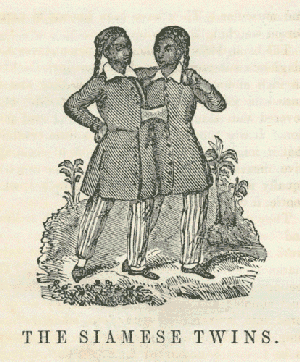
THE SIAMESE TWINS (pp 318-320):
In the year 1829, Captain Coffin, of the American ship Sachem, arrived
in the United States, with two youths, born in the kingdom of Siam, and
united by a strong gristly ligature at the breast. Their names were Eng
and Chang, and they were natives of Maklong, a village on the coast of
Siam. They were born in May, 1811, of Chinese parents, who were in humble
circumstances. They were engaged in fishing, keeping poultry, and manufacturing
cocoa-nut oil, till they left their country. When they arrived, they
were five feet two inches in height, well made, and muscular. They have
been known to carry a person weighing 280 pounds.
The band that united these two persons was a cartilaginous substance,
an eighth of an inch thick, and an inch and a half wide. It was flexible,
and permitted the youths to turn in either direction. It was covered with
skin, and seemed to be without pulsation. It was very strong, and of
so little sensibility, that it might be smartly pulled, without seeming
to give uneasiness. When touched in the centre, it was equally felt by
both; but at half an inch from the centre, it was felt by only one.
They were agile, could walk or run with swiftness, and could swim
well. Their intellectual powers were acute; they played at chess and
draughts remarkably well, but never against each other. Their feelings
were warm and affectionate, and their conduct amiable and well-regulated.
They never entered into conversation with each other, beyond a simple
remark made by one to the other, which seemed to be rationally accounted
for by the fact, that, in their experience being all in common, they had
nothing to communicate. The attempt has frequently been made to engage
them in separate conversations with different individuals, but always without
success, as they are invariably inclined to direct their attention to
the same thing at the same time. In their movements perfect equanimity
is observed; the one always occurring with the other, so that they appear
as if actuated by a common mind. In their employments and amusements,
they have never been known to utter an angry word towards each other.
Whatever pleases or displeases one has the same effect on the other.
They feel hunger and thirst at the same time, and the quantity of food
taken by them is as nearly alike as possible. Both feel the desire to sleep
simultaneously, and they always awake at the same moment. Upon the possibility
of separating them with safety, there is some difference of opinion among
medical men.
These two youths excited an extraordinary sensation upon their arrival
in this country. For three or four years, they were exhibited here,
and in Europe, and, finally, having obtained a competence, they purchased
a farm in North Carolina, and established themselves as planters, where
they still reside. They furnish the only instance in which two individuals
have been thus united, and their case has probably excited more interest
than any other freak of nature that has ever happened.
The most curious part of the story of Eng and Chang, is, that on
the 13th of April, 1843, they were married to two sisters, Sarah and
Adelaide Yeates, of Wilkes county, North Carolina!
[Note: Chang and Eng Bunker lived another thirty years after
the above was first published, and went on to father 21 children between
them. In the wake of the Civil War, the Bunkers lost a great deal of their
holdings and were forced to once again exhibit themselves — often appearing
with Eng's son Patrick Henry or John Montgomery and Chang's son Albert —
in order to rebuild their fortunes. They undertook several trips to Europe,
their last trip abroad being to Russia in 1870. Chang died in Eng's house
in Mount Airy, North Carolina during the early morning of January 17, 1874,
followed by his terrified brother two hours later. Fifteen days afterward,
the bodies were removed from a sealed casket stored in Eng's cellar, embalmed,
photographed and rudimentarily autopsied before being removed to Philadelphia
for further examination at the College of Physicians. A plaster death
cast and the twins' conjoined livers are today prominently displayed in
the collection of the College's Mütter Museum. (for an exhaustive account
of Chang & Eng's lives, please see Irving and Amy Wallace's The Two:
The Story of the Original Siamese Twins , Simon and Schuster: 1978)]
An 1837 newspaper advertisement for Chang and Eng may be seen
here
, and my tribute to the twins, The Bathers, may be seen
here
.
|

|

|

|
All Images and Text © James G. Mundie 2003 - 2010
|



